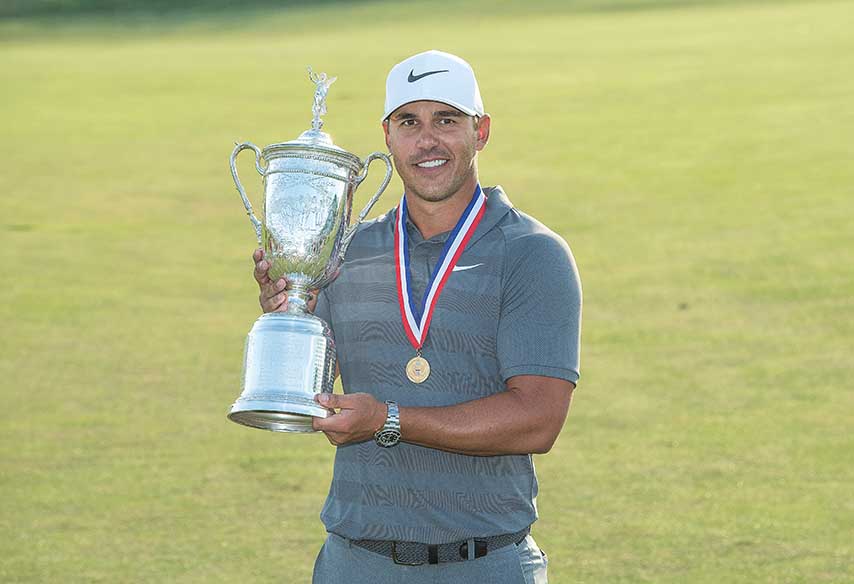Who could have known that a young Brooks Koepka would - rather than dedicating himself to a sport that he loved as a child and still does today (baseball) - go on to become a glittering international golfing star. Fate assigned a rather different stellar role to the boy who, now 28 years old, has become a dual and consecutive US Open champion.
At the age of 10, Brooks suffered a nasty broken nose when the car his nanny was driving was involved in an accident. He was unable to take part in contact sports that summer, so he spent his time playing golf at Okeeheelee Golf Course in West Palm Beach. He would have liked to devote himself body and soul to his beloved baseball - a love that was instilled in him by his father, a pitcher for West Virginia Wesleyan, and his great uncle Dick Groat, a legend of the sport and also of basketball (he played in the NBA ) - but circumstances took him by along other paths.
“If I had another opportunity to do so, I would play baseball, 100 per cent,” Koepka once said in an interview. If there is any further doubt about his sporting preferences, the American star observed one year ago, after winning his first US Open at Erin Hills, that “golf is boring: it doesn’t involve much action”.

Despite that boredom, Brooks cannot complain, of course, in both a sporting and a financial sense. Retaining a Grand Slam title is a feat that has only been achieved by an exclusive club of stars. Koepka for example, is just the seventh player to win successive US Opens. Previously this was achieved by Willie Anderson (1903-1904), John McDermott (1911-1912), Bobby Jones (1929-1930), Ralph Guldahl (1937-1938), Ben Hogan (1950-1951) and Curtis Strange (1988-1989).
One other pioneering achievement that further reinforced his curriculum was pocketing the highest prizemoney in a golf tournament: $ 2,160,000, the same amount he won for his triumph last year, when the USGA decided to increase the US Open prize fund by one million compared with 2016, thus boosting it to $12 million - $2 million more than at the Masters, $3,550,000 greater than the British Open total and $1.5 million up on the PGA Championship.
Koepka's feat seems even more amazing bearing in mind that, before his first win US Open last year, he had only achieved one other victory on the US PGA Tour and another on the European Tour, where he played at the beginning of his professional career as he could not qualify for the PGA Tour. Nevertheless, this relative lack of victories does not tarnish an otherwise impressive record, reflected in the numerous top-10s in his career and his outstanding performance in the last Ryder Cup, when he recorded three wins and a draw.
Into the Global Spotlight
Brooks Koepka first attracted media attention in June 2012 when, aged 22 and still an amateur, he played in the US Open after a brilliant performance in the pre-qualifiers - although he subsequently missed the cut. One year later, he made his professional debut at the Credit Suisse Challenge, his first contact with the European Challenge Tour. He went on to compete in 20 Challenge Tour events in 2012 and 2013, winning four times, which earned him a card for the main European Tour. Five years later, those first modest steps in the professional ranks led to him equalling, at Erin Hills ,the best winning score in the history of the US Open: 16-under, the same result achieved by Rory McIlroy in 2011.
In this year’s edition of the US Open, the winning score of one-over was considerably higher than his previous effort, but victory for Brooks was just as glorious - even if he continues to love baseball. He is also still a long way off emulating one of his famous neighbours, Tiger Woods, another resident of Jupiter (Florida), where Koepka is a member at Medalist Golf Club in Hobe Sound.
As for his season up until the US Open, Koepka had collected three top-10 finishes, including two runner-up places in the Forth Worth Invitational and HSBC World Golf Championship, and had accumulated $3,955.41 in prizemoney. He missed the first major of the year, the US Masters, due to a wrist injury.
Throughout his career on the PGA Tour, Koepka (born in West Palm Beach, Florida) has played in 95 tournaments, made the cut in 78 and finished in the top-10 in 27, with six second places and three thirds. His earnings from when he joined the Tour until his second win at the US Open amounted to $17,520,172.
Of the 17 majors he has played in so far (including the aforementioned US Open as an amateur), Koepka has registered seven top-10s: his two triumphs in the US Open, two fourth places (2014 US Open and 2016 PGA Championship), one fifth (2015 PGA Championship), one sixth (2017 British Open) and a 10th (2015 British Open).
IN BRIEF
• Brooks Koepka has a younger brother who also plays professional golf. Chase Koepka is currently competing on the European Challenge Tour and in June he was ranked 38th in the Road to Oman season-long classification.
• Brooks likes several other sports including baseball, basketball, table tennis, soccer (or football, as we know it in Europe) and, of course, American football. The dual US Open champion is also a fishing enthusiast.
• Koepka recorded a 3-1-0 (wins-ties-losses) result during his Ryder Cup debut two years ago when the Americans won at at Hazeltine National. He made a key contribution to his team’s triumph.
• The US Open champion’s girlfriend is 29-year-old actress Jena Sims, who has played supporting roles to Morgan Freeman, Michael Douglas and Robert DeNiro. He had previously dated American soccer team player Becky Edwards.
• Seeing his mother beat breast cancer while he was in university gave him another perspective on life. “It made me realise that life can end very abruptly, so you have to enjoy it. Make people laugh, be optimistic. Try not to take everything seriously."
• During his time as a student at Florida State University, he won the ACC golfer of the year award twice, and he holds the school record for the best stroke average (71.85) and best single season average (71.09).




